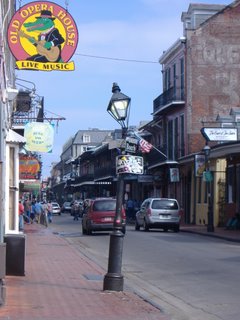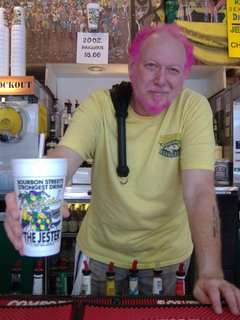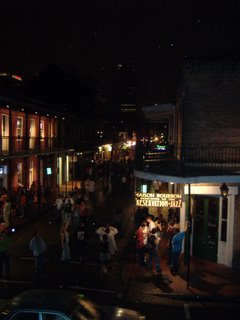Bourbon Street is a rumor.

How does one describe Bourbon Street? Since I live in New Orleans, my friends are curious to know what its like on this famous avenue. New Orleans is renowned everywhere for its rich culture, music, architecture, and cuisine, and Bourbon Street is a category in itself. It has evolved into a social and cultural icon that New Orleans has invested upon. The city even relied on Bourbon Street after the storm to bring back the tourists. But what makes Bourbon Street like no other place? I began to wonder why so many people were fascinated with a place they had only heard stories about and very few witnessed. In a way, Bourbon Street is a rumor. Rumors are stories that spread like wildfire, they are believed and passed whether they are true or not, and its truth is only revealed upon firsthand experience. Before now, I heard the stories and had built it up in my mind as this crazy place that acts like its Mardi Gras every night. So naturally, I had to visit. To discover my own interpretation and also to find out the truth behind its iconographical status, I had to visit the place myself.
I started my journey on a cool, crisp Saturday afternoon. Deliberately avoiding the narrow, tourist drawn streets of the French Quarter, which are especially packed on Saturdays, I decided to park my car in a parking lot about three blocks away from Bourbon Street, on North Peters Street and walk around. As I made my trek up Toulouse, I passed the intersections of Chartres and Royal, filled with groups of impressionable tourists carrying maps and shopping bags.
As I finally reached my destination, I realized the nearly empty street was almost silent, with the exception of the sound of a lone saxophone coming from an even emptier bar. I noticed many trash cans that were overflowing with the contents of the night before.
 As I passed a few bars, I couldn’t tell if some of the them were closed just during the day or have remained that way since Hurricane Katrina. So in a way as Bourbon Street is recovering, so are the people that partake in the late night festivities on the avenue.
As I passed a few bars, I couldn’t tell if some of the them were closed just during the day or have remained that way since Hurricane Katrina. So in a way as Bourbon Street is recovering, so are the people that partake in the late night festivities on the avenue. 
I soon became thirsty and was in search of a quick refreshment. With so many choices, how does one decide?
 It was just my luck, as a daiquiri bar on the corner of Bourbon and Conti caught my eye. It was called “The Jester” and like many of the bars and clubs along Bourbon Street, it was very open and inviting. There were three people seated at the bar and a very colorful, yet knowledgeable bartender.
It was just my luck, as a daiquiri bar on the corner of Bourbon and Conti caught my eye. It was called “The Jester” and like many of the bars and clubs along Bourbon Street, it was very open and inviting. There were three people seated at the bar and a very colorful, yet knowledgeable bartender. 
“What can I get ya, Babe?” he asked.
Hmm. There were twelve flavors to choose from and each one sounded very delicious. I asked the bartender, Eddie, he would later tell me, what his favorite was. He suggested their specialty named for the bar, the Jester and I trusted his choice. He served me the green concoction and my mouth felt a surge of lemon lime goodness. Since he wasn’t busy with the other customers, Eddie and I began to make small talk with Eddie. I told him I was from Kentucky and new to the area. Eddie said he had lived in New Orleans for the past seventeen years, including the two months he spent outside the city during the aftermath of Katrina. He returned because he missed the sound of the city that would echo in his home in the French Quarter.
He seemed rather informed about the area so I asked him my burning question. When and how did Bourbon Street become so popular? Eddie believes the nostalgia of Bourbon Street began when its former district of Storyville was forced to close in 1917, due to the United States Navy refusing to have its base so close to legalized brothels.
 Storyville culturally constructed the image of New Orleans as a good time town and today, Bourbon Street conveys that image with its bars and gentleman clubs. Its first night club opened in 1925 as well as the opening of its first burlesque clubs for soldiers when World War II began. When the war ended, tourism increased as well as the need for more restaurants and hotels, and other means of entertainment. Over time, businesses began to focus on more evening associated entertainment. “But why Bourbon Street,” I asked. It is simply because it’s positioned on a major thoroughfare in the district. Interested in witnessing the nightlife firsthand, I said goodbye to Eddie. But before I left, he added that its popularity may also stem from allowing American tourists to experience something that isn’t available in other parts of the United States. I thanked him, grabbed my “go-cup” and went on my way anticipating the experiences that would await me later in the evening.
Storyville culturally constructed the image of New Orleans as a good time town and today, Bourbon Street conveys that image with its bars and gentleman clubs. Its first night club opened in 1925 as well as the opening of its first burlesque clubs for soldiers when World War II began. When the war ended, tourism increased as well as the need for more restaurants and hotels, and other means of entertainment. Over time, businesses began to focus on more evening associated entertainment. “But why Bourbon Street,” I asked. It is simply because it’s positioned on a major thoroughfare in the district. Interested in witnessing the nightlife firsthand, I said goodbye to Eddie. But before I left, he added that its popularity may also stem from allowing American tourists to experience something that isn’t available in other parts of the United States. I thanked him, grabbed my “go-cup” and went on my way anticipating the experiences that would await me later in the evening.When I returned that night,
 I again passed groups of tourists now carrying drinks and many strands of colorful plastic beads. The once nearly empty street was now flooded with revelers taking in the wild nightlife that Bourbon Street has to offer. I walked by five star hotels that were within walking distance to gentleman clubs. Even on street corners there were moments of disparity where a scantily clad cross dresser was sharing a street corner with a highly successful business man. Bourbon Street has the ability to bring together different people and places to coincide.
I again passed groups of tourists now carrying drinks and many strands of colorful plastic beads. The once nearly empty street was now flooded with revelers taking in the wild nightlife that Bourbon Street has to offer. I walked by five star hotels that were within walking distance to gentleman clubs. Even on street corners there were moments of disparity where a scantily clad cross dresser was sharing a street corner with a highly successful business man. Bourbon Street has the ability to bring together different people and places to coincide. There are music clubs that line Bourbon Street as well. The closest association to where jazz was developed in New Orleans, I was told, is at Preservation Hall.
 Wanting to take in the scene of traditional jazz amidst an array of karaoke bars and dance clubs, a worker informed me that they were closing. The only way I could come in was to get a drink. I was upset by this news and settled for dancing to a melody-challenged singer crooning on a karaoke stage across the street at the Cat’s Meow.
Wanting to take in the scene of traditional jazz amidst an array of karaoke bars and dance clubs, a worker informed me that they were closing. The only way I could come in was to get a drink. I was upset by this news and settled for dancing to a melody-challenged singer crooning on a karaoke stage across the street at the Cat’s Meow.  Before too long, the dance floor became extremely crowded. A late-night misty rain had fallen, which forced some to take shelter inside, while others remained dancing in the streets.
Before too long, the dance floor became extremely crowded. A late-night misty rain had fallen, which forced some to take shelter inside, while others remained dancing in the streets. Eventually, just like the rain, my night on Bourbon Street had come to an end, although it became clear to me that the party would still live on even without my presence.
 The neon signs that lit up the dark cloudy night would still burn just as brightly as they would during the day. Musicians would hang up their microphones and close up their pianos just to perform again the next night. Dedicated revelers would resist signs of weariness before they ultimately gave up to its clutch.
The neon signs that lit up the dark cloudy night would still burn just as brightly as they would during the day. Musicians would hang up their microphones and close up their pianos just to perform again the next night. Dedicated revelers would resist signs of weariness before they ultimately gave up to its clutch.I returned home still as unclear as to the true meaning of Bourbon Street as when I had left.
 I interpreted Bourbon Street as ambiguous. It can’t be defined. It’s an experience. It must be felt. Don’t believe the rumors and don’t believe what I’ve told you. Come see it for yourself.
I interpreted Bourbon Street as ambiguous. It can’t be defined. It’s an experience. It must be felt. Don’t believe the rumors and don’t believe what I’ve told you. Come see it for yourself.-Lindsey Fister-

0 Comments:
Post a Comment
<< Home